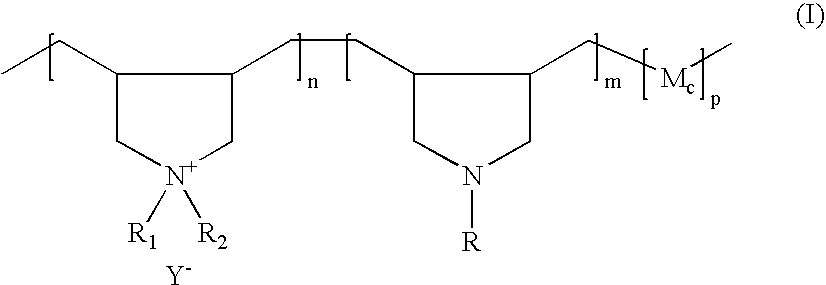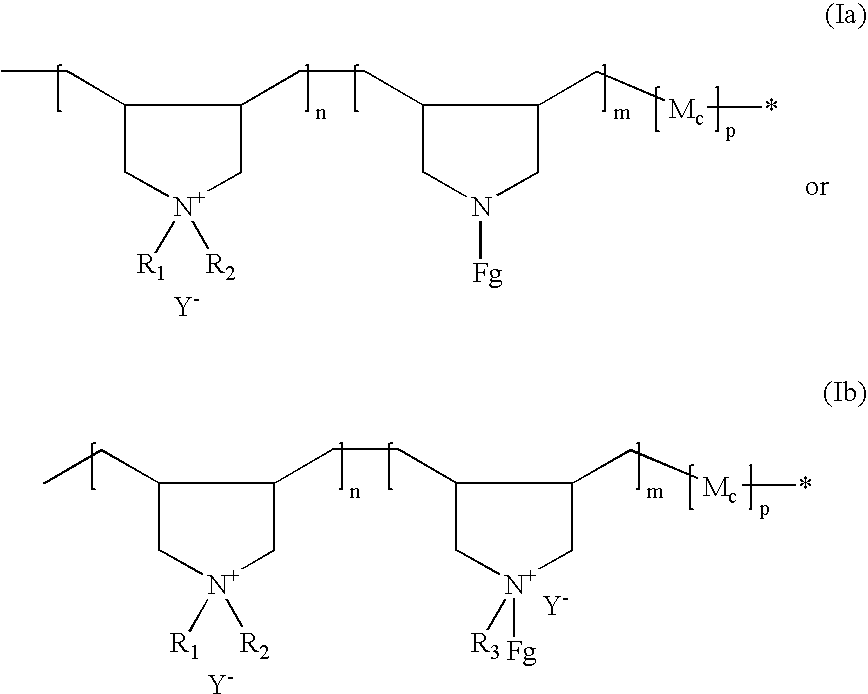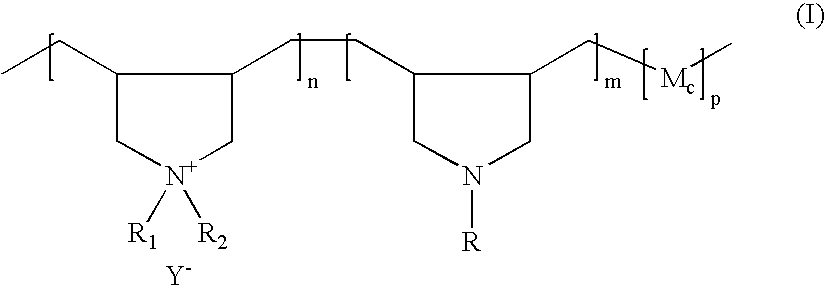Preparation of functionalized cationic polymers & their application in personal care
a functionalized cationic polymer, personal care technology, applied in the direction of detergent compounding agents, medical preparations, drug compositions, etc., can solve the problems of bringing along undesirable attributes, reducing hair volume, and tackiness, and achieve the effect of enhancing the properties of skin care compositions and exceptional conditioning properties on hair
- Summary
- Abstract
- Description
- Claims
- Application Information
AI Technical Summary
Benefits of technology
Problems solved by technology
Method used
Image
Examples
example 1
Synthesis of pDADMAC / DAA Copolymer
[0172] A 1-liter reactor equipped with a condenser, a thermometer, a nitrogen inlet and an overhead agitator is charged with 260 g of 66% DADMAC monomer, 34.5 g of diallylamine (DAA), 35.0 g of HCl solution, 6.0 g of deionized water, and 0.4 g of 20% Na4EDTA solution. The polymerization mixture is purged with nitrogen and heated with agitation to a temperature of 80° C. An aqueous solution containing 2.1 g of ammonium persulfate (APS) is slowly fed to the reaction mixture over 190 minutes. The reaction temperature is allowed to increase to above 90° C. and then maintained at 90 to 100° C. during the APS feed period. After the APS feed, the reaction temperature is held at 95° C. for about 30 minutes. Then an aqueous solution containing 6 g of sodium metabisulfite (MBS) is added over 30 minutes. The reaction mixture is held at 95° C. for another 30 minutes to complete the polymerization (above 99% conversion). The polymer solution is then diluted wi...
example 2
[0173] Following the same procedure as Example 1 the following polymers (in Table 1 below) are synthesized. The final product viscosities are measured at 25° C. using a Brookfield viscometer using a Brookfield LVT #3 spindle at 12 rpms. The viscosity results are shown in Table 1 below.
TABLE 1Sample% DAA% SolidsViscosity (cps)A19.541.84900B9.7540.98100C4.836.94000D7.537.711000
example 3
[0174] A 0.5-liter reactor fitted with a mechanical stirrer, addition funnel and condenser is charged with 228.0 grams (0.129 mole secondary amine, NH) of the base polymer from Example 1. The reactor content is adjusted with 6.0 g of 25% NaOH aqueous solution to a pH of 9.0 to 10.0 and heated to 70° C. with agitation. After the pH adjustment, 7.6 g (0.0076 mole epoxide) of mono-(2,3-epoxy)propyl ether-terminated polydimethylsiloxane (MCR-E11 from the Gelest) is added into the reactor. The grafting reaction is maintained at about 70° C. and the viscosity of the reaction solution is monitored with an agitator torque meter. The viscosity of the reactor contents, as is indicated by the torque meter reading, increases with reaction time. The viscosity increase is believed to result from association of grafted hydrophobic siloxane groups and can be an indication of the grafting reaction. While the viscosity shows little further increase with increasing reaction time after about four hours...
PUM
| Property | Measurement | Unit |
|---|---|---|
| Fraction | aaaaa | aaaaa |
| Percent by mass | aaaaa | aaaaa |
| Percent by mass | aaaaa | aaaaa |
Abstract
Description
Claims
Application Information
 Login to View More
Login to View More - R&D
- Intellectual Property
- Life Sciences
- Materials
- Tech Scout
- Unparalleled Data Quality
- Higher Quality Content
- 60% Fewer Hallucinations
Browse by: Latest US Patents, China's latest patents, Technical Efficacy Thesaurus, Application Domain, Technology Topic, Popular Technical Reports.
© 2025 PatSnap. All rights reserved.Legal|Privacy policy|Modern Slavery Act Transparency Statement|Sitemap|About US| Contact US: help@patsnap.com



